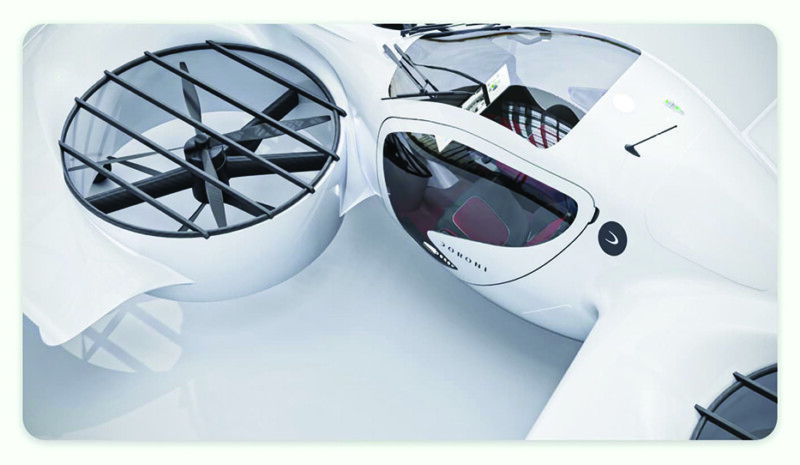
In the 1865 novel From the Earth to the Moon by the French novelist Jules Verne, American Civil War veterans invent a huge cannon capable of launching a projectile that can carry three men to the lunar surface. The book, and the film adaptation that later followed, took hold of the popular imagination and inspired generations to come. A little over a century after Verne published his story, three Americans astronauts perched atop a rocket and successfully completed the first manned mission to the moon.
What was a pure fantasy became reality when rocketry, computers and other scientific advancements caught up with Verne’s imaginative vision of space travel. Today, as humans navigate the 21st century, a new technology born of science fiction will also become reality: flying cars. These zero emission, high-mobility flyers, which go by the acronym eVTOL, Electric Vertical Take-off and Landing vehicles, are set to transform travel.
One such flying car is Doroni Aerospace’s H1 “Hummingbird,” a two-seat vehicle accommodating both pilot and passenger that recently was certified by the FAA and is slated to be released in 2025. It is designed to live in a two-car garage and does not require a pilot’s license to fly from home.
“For those of us who are geeks and are passionate about creating the world, we knew flying cars were coming,” Doron Merdinger, CEO of Doroni Aerospace, told Jetset Magazine. “The biggest question was: ‘how would they work’?
Merdinger said it was the combination of drone and EV battery technology that provided the practical means to produce flying cars like the H1. The “Hummingbird” is better described as a hover car with its large, ducted fans and the ability to float effortlessly like its namesake bird. It has a 60-mile range, a cruising speed of hundred miles per hour, and a top speed of 140 mph, Merdinger said, adding that the H1 would fly “hundreds of feet” in the air.

Doroni’s eVTOL is also semi-autonomous, meaning it’s easy to fly with only a limited amount of flight training. The appeal is in the simplicity of flight. The driver just taxis out of the garage and after “three-clicks-of-a-button” you’re flying, Doroni said.
But the major selling point, especially for those new to recreational flight, is safety. The H1 is built out of carbon fiber, comes equipped with self-stabilizing failsafes and even has a ballistic parachute. During the prototype’s maiden flight, Merdinger piloted the H1 inside the confined space of a hangar, demonstrating the nimbleness and stability of the airframe.
“When you are flying, you just feel better,” said Merdinger. “It’s about experiencing the world. Your perception of time and space is going to change.”
Doroni has completed 70 successful manned flights so far. The company expects its first “to-market” model to be unveiled in the next couple months at a price between $300,000 and $400,000, Merdinger said.
Dawn of the eVTOL
A dreamer by nature, Merdinger, a 58 year-old father of three who lives in South Florida, was an asthmatic child growing up in Israel. Unable to participate in sports, he found himself tinkering around the house and inventing things. Hollywood movies featuring flying cars like Chitty Chitty Bang, and later The Fifth Element, captured his imagination. As an adult Merdinger was stuck in traffic one day, watching a drone fly by, when he realized the technology for a flying car had arrived. His “eureka moment” happened as he observed the toy’s agility in the air and its responsiveness to the child who operated it remotely nearby.
Merdginer said he believes the dominance of combustion cars and helicopters is coming to an end. He says eVTOsL have the potential to significantly ease the urban congestion plaguing many American cities by moving some of the ground transportation into the skies. He predicts gas-powered cars and helicopters will become obsolete due to the environmental damage they cause.
“People are frustrated by traffic jams, pollution and the destruction of the ecosystem,” Merdinger said. “Why destroy nature and create congestion in our urban spaces if you have the technology to circumvent these problems?”

Merdinger’s belief in the flying car and in eVTOL technology comes as cities and regulatory agencies prepare for an eVTOL revolution. Flying cars, air taxis and unmanned drones will undoubtedly make the skies busier, causing headaches for regulatory agencies charged with public safety. In eVTOL developer circles this is called Air Traffic Management (ATM). The hope is that safety measures like geofencing, a GPS technology used in drones to create virtual boundaries and prevent collisions, will prevent the skies from devolving into a free-for-all.
But aside from the challenges awaiting the eVTOL, leading industry companies continue to take important steps forward. Joby Aviation delivered its first eVTOL to the U.S. Air Force as part of its contract with the Department of Defense and Archer Aviation partnered with United Airlines to create the first commercial eVTOL air taxi route in Chicago. Such developments further signal that eVTOL aircraft are an inevitability.
Doroni plans on unveiling the company’s H1 market prototype sometime in the next couple of months, Merdinger said, with ‘preorder requests’ for the “Hummingbird” already totaling 370. In fact, the H1 is not alone in luring in would-be flyers clamoring to own a personal eVTOL. The ultralight, Jetson One, a one seat flying machine, reportedly has thousands of preorders.
Doroni has also raised over $4.5 million and continues to seek investment as the company heads into 2024, according to their website. Merdinger said some of the H1’s potential buyers are already planning to use a flying car to commute. Because why sit in traffic when you can fly to work every day?
“The technology is here,” said Merdinger. “Now it’s about making it happen.”






